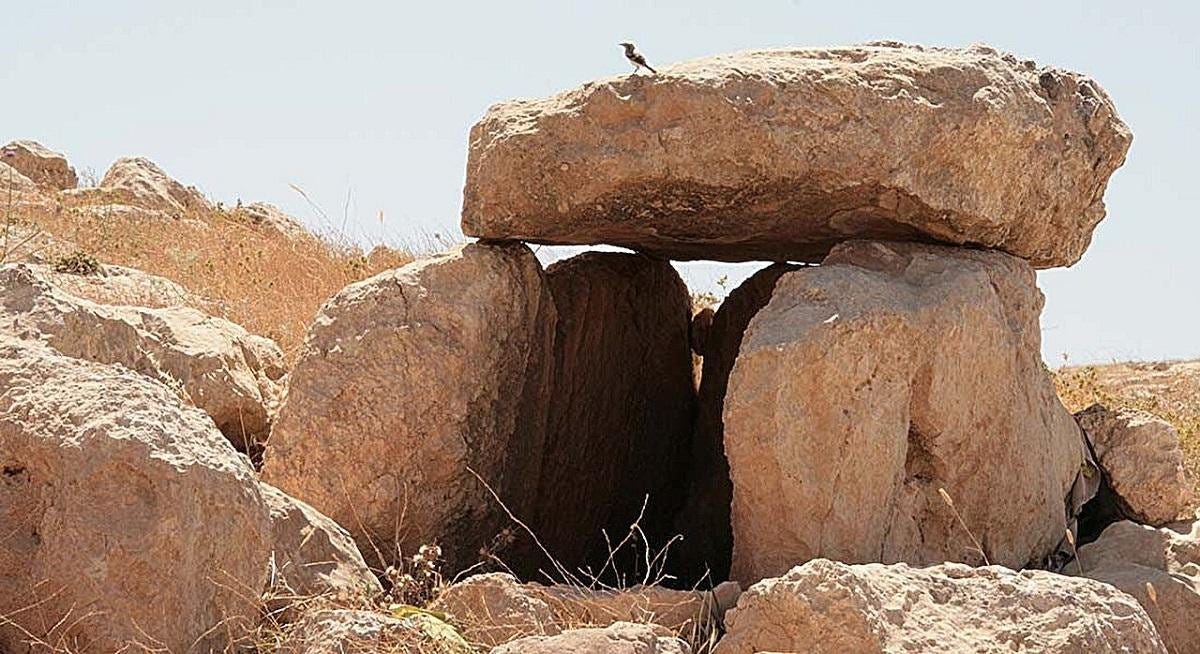🧐 Ancient Beat #171: Ritual landscapes, missing lineages, and shifts in the timeline
Hello, friends — welcome to issue #171 of Ancient Beat!
Here’s the latest ancient news. 👇
🗞 Ancient News: Top 5
5,500-Year-Old Ceremonial Site Unearthed In Jordan Reveals How Ancient Societies Adapted To Crisis — In central Jordan’s Murayghat region, archaeologists have uncovered a vast Early Bronze Age ritual landscape dating to roughly 3500–3000 BCE. Spread across the hills southwest of Madaba, the site features more than 95 dolmens—massive stone burial-like chambers up to 13 feet long—arranged around a central hilltop marked by standing stones, cairns, and carved bedrock platforms. The absence of human remains or domestic debris sugggests the site served not as a settlement but as a ceremonial gathering place for remembrance and unity. Finds such as flint tools, basalt grinders, horn cores, and oversized pottery vessels (some holding up to 6.5 gallons) suggest communal feasting or offerings. Built after the collapse of Chalcolithic villages and amid climate stress and social breakdown, Murayghat reflects how early Levantine communities turned to monument building and ritual landscapes to restore identity, cohesion, and continuity in the face of crisis.
Epigraphists Identify Ix Ch’ak Ch’een – The Woman Who Ruled Cobá — Newly deciphered inscriptions from the ancient Maya city of Cobá in Quintana Roo, Mexico, confirm that a woman named Ix Ch’ak Ch’een ruled during the 6th century CE. The text, carved on a large monument known as Foundation Rock near the Nohoch Mul pyramid complex, records events from 569 CE, including the creation of a political institution called kaloomte’ at a site referred to as “place of the deer mountain.” Additional references on other monuments link Ix Ch’ak Ch’een to major building projects, including the city’s Group D ballcourt, and to the completion of a 20-year k’atun cycle in 573 CE. Her titles and divine associations—such as ties to the storm and lightning deity K’awiil—underscore her prominence within Cobá’s royal lineage. The inscriptions also connect her rule to local protective spirits and sacred water features near the Nohoch Mul aguada, revealing how Cobá’s political and spiritual life were intertwined in both landscape and myth.
New Study Shifts the Dating of Major Bronze Age Events — A new scientific study presents fresh evidence (including mud-bricks, linen cloths and wooden shabtis) that the massive volcanic eruption of Thera (modern-day Santorini, Greece) likely occurred before the reign of Pharaoh Ahmose I. This pushes the eruption into the earlier Second Intermediate Period rather than the early New Kingdom, challenging the long-held synchronisation of Aegean, Anatolian and Egyptian Bronze Age chronology. It shifts a key chronological anchor point for the Late Bronze Age—meaning many events tied to the eruption’s timing may need adjustment.
A 15th-Century Inca Building Was Built For Sound—Researchers Are Working To Understand Why — In the remote Andean town of Huaytará, Peru, archaeologists are studying a rare 15th-century Inca structure known as a carpa uasi—a partially open, three-walled “tent house” designed to amplify sound. Unlike typical Inca stonework, this building prioritized acoustics over stability, suggesting that the Incas valued sound as a central element of ritual and communication. Its design likely projected low-frequency sounds such as drumming across the surrounding valley, perhaps to mark ceremonies or signal events like battles. The carpa uasi may have amplified these sounds with minimal echo through its arched, open-ended architecture. Though less stable than most Inca constructions, it survived because Spanish settlers later built the Church of San Juan Bautista over it, reinforcing its foundations. The study sheds new light on the Incas’ mastery of “aural architecture,” revealing how deeply sound, space, and the sacred were intertwined in Andean civilization.
The Missing Denisovan Shadow — Recent ancient-genome work has identified a previously unknown East Asian hominin lineage that complicates the narrative of human and archaic hominin interaction in Eurasia. The lineage appears distinct from both Denisovans and Neanderthals, suggesting a more complex web of populations contributing to modern human ancestry. It raises fresh questions about how widespread, how common, and how biologically influential these archaic lineages were — particularly in East and Southeast Asia.
That’s it for the free Top 5! If you’re a free subscriber, sign up for the paid plan for another 24 discoveries and 4 recommended pieces of content covering ruins, mosaics, and standing stones.
Until next time, thanks for joining me!
-James
Twitter: @jamesofthedrum
P.S. Here’s my Buy Me A Coffee link if you’d like to support my efforts with a donation.
P.P.S. If you want access to the paid version but it’s a little too steep for you right now, just email me — I want this to be accessible.
P.P.P.S. Paid members, read on!
🗞 Ancient News: Deep Dive
Keep reading with a 7-day free trial
Subscribe to Ancient Beat to keep reading this post and get 7 days of free access to the full post archives.


